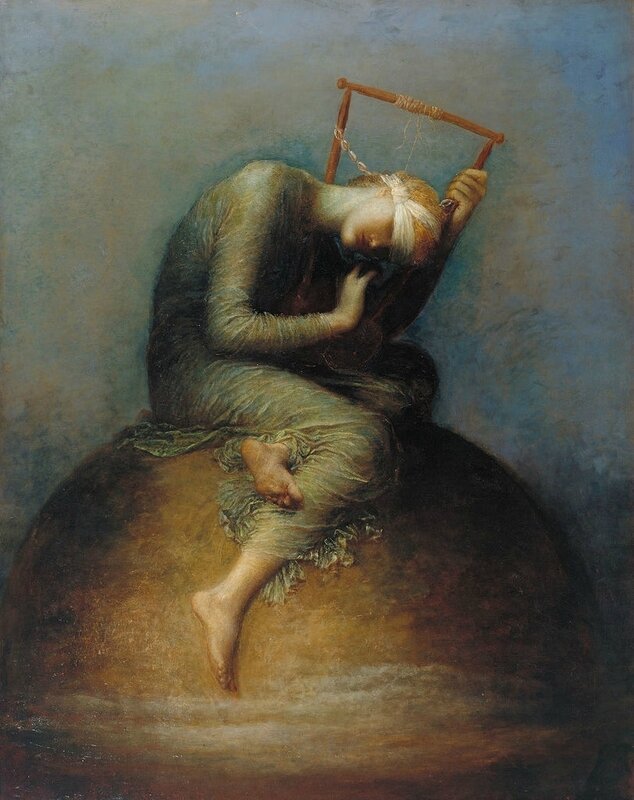Exhibition of masterpieces by Victorian painter and sculptor George Frederic Watts opens
George Frederic Watts (1817 - 1904), Self-Portrait of the Artist in Middle Age, 1879, Watts Gallery Collection
COMPTON.- Watts Gallery Trust today announced an unprecedented exhibition of the most important masterpieces by the celebrated Victorian painter and sculptor George Frederic Watts (1817-1904)..
Celebrating 200 years since the birth of the artist in London in 1817, England’s Michelangelo brings together the artist’s most significant paintings from public and private collections. For the first time since their restoration in 2011, the historic galleries at Watts Gallery, designed by Watts himself, are being used for a temporary exhibition.
George F. Watts (1817 - 1904), Found Drowned, circa 1848-1850, oil, Watts Gallery Trust
Watts became a cultural icon who championed a new role for art as a means of symbolically expressing the progress of humanity, and as a tool to assist in philanthropic projects. His imagery was carried all over the world through reproduction, making him the most internationally recognised British artist of the age. In 1884 Watts became the first living artist to have a solo exhibition at the Metropolitan Museum of Art in New York.
This exhibition offers an overview of Watts’ creativity over a period of more than fifty years. The central themes of his art – colour, cosmos, celebrity – evolved but remained essentially consistent, creating a remarkably coherent body of work traversing a period stretching from the age of Turner to that of Picasso.
George F. Watts (1817 - 1904), Choosing (Ellen Terry), 1864, oil, National Portrait Gallery, London
The exhibition takes its title, England’s Michelangelo, from the name given to Watts by his contemporaries who saw in his art great ambition, generosity and range.
England’s Michelangelo revolves around a series of key cycles of works by Watts. A selection of early paintings centres upon the monumental figures of Satan (1847; WGT) and The Good Samaritan (1848; Manchester Art Gallery). While Satan established Watts’ reputation among leading critics such as John Ruskin, The Good Samaritan was given to the city of Manchester in honour of Thomas Wright, a working-class prison reformer, beginning Watts’ life-long commitment to the campaigning potential of art.
George F. Watts (1817 - 1904), The Good Samaritan, 1850, oil, Manchester City Galleries
Watts’ extensive practice as a portraitist is represented by works such as Choosing (1864; National Portrait Gallery, London), showing his first wife, the teenage actress Ellen Terry, and Marie Fox, Princess Liechtenstein (1870s; private collection), a work never before seen in public.
At the centre of England’s Michelangelo is a room devoted to Watts’ most ambitious allegorical and Symbolist works. Here his famous Hope (1886; private collection), the picture which changed the life of President Obama, has been joined by major paintings including Love and Life (1880s; private collection) which also has a presidential association: given by Watts to the American people, it formerly hung in the White House.
George F. Watts (1817 - 1904), Satan, circa 1847-48, oil, Watts Gallery Trust
Other key loans include the Sower of the Systems (1902; Art Gallery of Ontario). Not seen in the UK for over a century, this almost abstract work represents Watts’ late attempt to personify new astronomical discoveries.
Throughout 2017, Watts Gallery will showcase the artist through four distinct mediums: drawing, painting, mural and sculpture.
George Frederic Watts (1817 - 1904), Marie Fox Princess Lichtenstein, early 1870s. Private Collection.
Dr Nicholas Tromans, Brice Curator of Watts Gallery—Artists’ Village, says: “Watts was the most admired British artist of the late nineteenth century, and England’s Michelangelo will show why. We have set out to bring absolutely the very finest works by the artist to Compton to create a Watts exhibition like nothing seen before. The exhibition will emphasise the great originality and power of Watts as a painter, the glamour of his portraiture and the magnificence of his Symbolist works which so impressed all of Europe."
George F. Watts (1817 - 1904), Mrs. Lillie Langtry, circa 1879-1880. Oil.
George F. Watts (1817 - 1904), "Second version of Hope", 1886, Tate Britain

/https%3A%2F%2Fprofilepics.canalblog.com%2Fprofilepics%2F1%2F0%2F100183.jpg)
/https%3A%2F%2Fstorage.canalblog.com%2F03%2F02%2F119589%2F96711876_o.jpg)
/https%3A%2F%2Fstorage.canalblog.com%2F11%2F31%2F119589%2F94773502_o.jpg)
/https%3A%2F%2Fstorage.canalblog.com%2F20%2F83%2F119589%2F94772815_o.jpg)
/https%3A%2F%2Fstorage.canalblog.com%2F26%2F72%2F119589%2F75604929_o.jpg)
/https%3A%2F%2Fstorage.canalblog.com%2F59%2F60%2F119589%2F26458628_o.jpg)










/http%3A%2F%2Fstorage.canalblog.com%2F46%2F29%2F119589%2F75423425_o.jpg)
/image%2F1371349%2F20240425%2Fob_c453b7_439605604-1657274835042529-47869416345.jpg)
/image%2F1371349%2F20240425%2Fob_59c6f0_440358655-1657722021664477-71089985267.jpg)
/image%2F1371349%2F20240425%2Fob_07a28e_440353390-1657720444997968-29046181244.jpg)